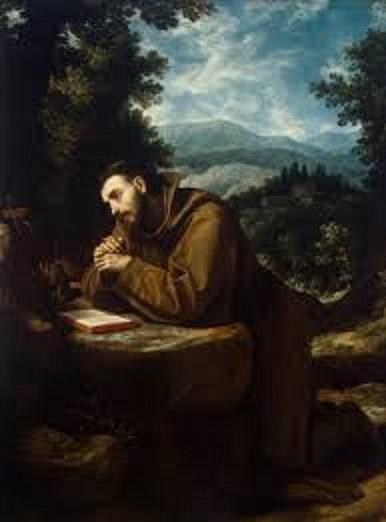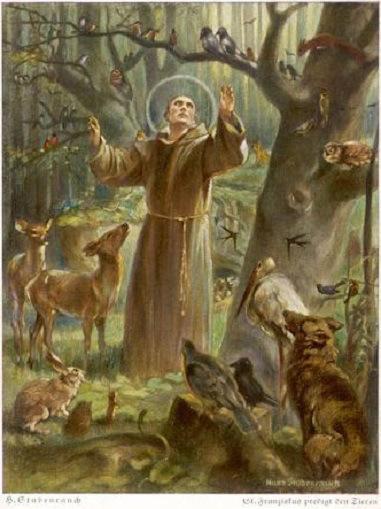When former Argentinian archbishop Jorge Bergoglio was elected pope in 2013, he selected Francis as his papal name — St. Francis of Assisi.
St. Francis is an unusual saint in that he is known and admired by even non-Catholics and non-Christians. Lamentably, most of his admirers know only one facet of St. Francis — his endearing closeness with birds and animals. But there is so much more to this saint.
Did you know that St. Francis was called by Jesus Christ our Lord to reform and repair the Catholic Church, which had fallen to a corrupt and heretical clergy?
History repeats itself, and we find a Church similarly in disrepair in our own time. May St. Francis be a reminder and role model for all faithful clergy and laity as we are called, as he was, to repair and reform a Church in disarray. See:
- Calif. Catholic diocese publishes homily by priest advocating for homosexuality and gay marriage
- Radical homosexual priest appointed to Vatican says gay sex can express Jesus’ “self-gift”
- Pope Francis praises homosexual children’s book
- The Rotten Fruits of Pope Francis: church schism, conservative rebellion, and approval of Iran nuke deal
- The Illegitimate Pope: Election of Jorge Bergoglio as Pope Francis was contaminated by lobbying in violation of papal laws
To that end, I’m republishing excerpts from joandarc’s post from a year ago, “St. Francis of Assisi – Happy Feast Day – October 4th!“.
~Éowyn

Dante Alighieri, the famous poet, the author of the Divine Comedy, said of St. Francis, “A sun was born into the world.” Francis was born at the end of 1181 or the beginning of 1182, to a rich family, his father being a successful cloth merchant and being raised by an adoring French mother. He lived a carefree life, most interested in chivalrous ideals and chivalrous dreams of greatness and nobility. Francis, age 20, participated in a military campaign, was taken prisoner and later released because he was so very ill. This illness caused Francis to search his soul and look inward to his purpose in life, to determine and define what was important in life. He had abandoned his worldly lifestyle and began to notice the beauty, purpose and virtues of God’s creatures, whom he loved and how they lived in simplicity.
One day, Francis rode the plain of Assisi and noticed a disfigured and horrible looking leper man. Francis got off his horse, wherein the leper outstretched his hands to receive alms. But Francis did more than give him money, he kissed the leper because he saw Jesus in Him, he saw “Jesus in disguise,” as Blessed Mother Teresa of Calcutta would say – an event that changed Francis’ life.
After his exchange with the leper, Francis visited hospitals, served the sick and the forgotten, gave clothes and money to those who needed it. On a particular day in or about 1205, Francis was praying at the Church of St. Damian outside the walls of Assisi when he heard a voice, an interior instruction that he took to heart, “Francis, go and repair my house, which you see is falling down.” Francis thought that Our Lord meant to repair that specific Church, when indeed and in fact Our Lord was referring Francis to renew and repair His Church. Pope Benedict XVI tells us, “…that at that moment, St. Francis was called to repair the small church, but the ruinous state of the building was a symbol of the dramatic and disquieting situation of the Church herself. At that time, the Church had a superficial faith which did not shape or transform life, a scarcely religious clergy, and a chilling of love. It was an interior destruction of the Church which also brought a decomposition of unity, with the birth of heretical movements. Yet, there at the center of the Church in ruins was the Crucified Lord, and he spoke: He called for renewal, He called Francis to the manual labor of repairing the small Church of St. Damian, the symbol of a much deeper call to Renew Christ’s own Church, with her radicality of faith and her loving enthusiasm for Christ.”
Francis took clothes and supplies from his father’s storage house, selling these items, as well as selling his father’s horse. He brought these monies to the priest at St. Damian, but the priest would not take the money, Francis leaving the money on a window sill. Francis’ father learned what had happened and demanded that Francis return everything that he had taken from him, reporting the matter to Bishop Guido of Assisi. The Bishop told Francis to return these monies to his father, “He (God) does not wish His Church to profit by goods which may have been gotten unjustly.” Francis responded, “The clothes I wear are also his. I’ll give them back.” He stripped off his clothes and gave them to his father saying, “Hitherto I have called you father on earth; but now I say, ‘Our Father, who art in Heaven. “ Clothes of a laborer were found and given to Francis, wherein Francis made a cross upon the cloth with some chalk and left.
In 1208, Francis lived as a hermit, but then had another internal transformation, affected by the Gospel of Matthew, Jesus’ discourse to the apostles whom he sent out to evangelize and teach the nations. Accordingly, Francis went out just as the apostles did to teach by example, living in poverty and preaching the Gospel. He had other brothers, companions who followed his way of life. On one particular day, Francis told the brothers they were going to preach. Francis and his band of brothers walked through a town but said nothing. One of the brothers asked Francis why they didn’t preach. Francis told him that they did preach saying, “Preach the Gospel constantly, and when necessary, use words.” It was, therefore, Francis’ example of holiness, and that of the brother companions, that taught the people of God.
Pope Benedict goes on to say that “Francis knew that the center of the Church is the Eucharist, where the Body of Christ and His Blood are made present through the priesthood, the Eucharist and the communion of the Church. Wherever the priesthood and the Eucharist and the Church come together, it is there alone that the world of God also dwells.”

Francis also had great communication skills with God’s creatures and control of them, a gift given to Him by God. “His love for and power over the lower animals were noted and often referred to by those who knew him: his rebuke to the swallows while he was preaching at Alvian, “My sisters the swallows, it is now my turn to speak. You have been talking enough all this time;” the birds that perched around him while he told them to praise their Creator; the rabbit that would not leave him at Lake Trasimene; and the tamed wolf at Gubbio…” Francis even had a pet falcon that he loved very much, who accompanied him wherever he went.
In 1224, Francis saw a vision of Jesus crucified in the form of a seraph, and after that vision, received the stigmata from the Seraph Crucifix, becoming one with the Crucified Jesus. Francis, thus, suffered with the wounds of Christ. Francis died humbly, on the earthen floor, on October 3, 1226, in the Portiuncula with his brother friars.
Consequently, the Universal Church celebrates the Feast Day of St. Francis every year on October 4.
Pope Benedict XVI summarized St. Francis beautifully. He said, “Dear friends, Francis was a great Saint and a joyful man. His simplicity, his humility, his faith, his love for Christ, his goodness towards every man and every woman, brought him gladness in every circumstance. Indeed, there subsists an intimate and indissoluble relationship between holiness and joy. A French writer once wrote that there is only one sorrow in the world: not to be saints, that is, not to be near to God. Looking at the testimony of St. Francis, we understand that this is the secret of true happiness: to become saints, close to God!”
Sources:
- General Audience of Pope Benedict XVI, Paul VI Audience Hall, January 27, 2010, website of the Vatican, the Holy See.
- “The Body of the Lord,” website of the Vatican.
- One Hundred Saints, Bulfinch Press, AOL Time Warner Book Group
~Joan

